
2
Evolutionary Methods for the
Design of Reliable Networks
Alice E. Smith and Berna Dengiz
2.1 Introduction to the Design Problem
The problem of how to design a network so that certain constraints are met and one or more
objectives are optimized is relevant in many real world applications in telecommunications
(Abuali et al., 1994a; Jan et al., 1993; Koh and Lee, 1995; Walters and Smith, 1995),
computer networking (Chopra et al., 1984; Pierre et al., 1995), water systems (Savic and
Walters, 1995) and oil and gas lines (Goldberg, 1989). This chapter focuses on design of
minimum cost reliable communications networks when a set of nodes and their topology
are given, along with a set of possible bi-directional arcs to connect them. A variety of
approaches are cited, and the previous work of the authors using genetic algorithms is
discussed in detail. It must be noted that the design problem solved by these methods is
significantly simplified. A large number of components and considerations are not treated
here. Instead, the approaches focus on the costs and reliabilities of the network links.
2.1.1 Costs
Costs can include material costs of the cabling, installation costs such as trenching or
boring, land or right of way costs, and connection or terminal costs inherent with the
cabling. Many of these are ‘unit costs’, i.e. they depend on the length of the arc. However,
there can be fixed costs per arc and these are easily accommodated in the methods
discussed. In many papers, a unit cost is not specifically mentioned; instead each arc is
assigned a weight which is used as the complete cost of the arc (Aggarwal et al., 1982;
Atiqullah and Rao, 1993; Kumar et al., 1995).
Telecommunications Optimization: Heuristic and Adaptive Techniques, edited by D.W. Corne, M.J. Oates and G.D. Smith
© 2000 John Wiley & Sons, Ltd
Telecommunications Optimization: Heuristic and Adaptive Techniques.
Edited by David W. Corne, Martin J. Oates, George D. Smith
Copyright © 2000 John Wiley & Sons Ltd
ISBNs: 0-471-98855-3 (Hardback); 0-470-84163X (Electronic)

18 Telecommunications Optimization: Heuristic and Adaptive Techniques
2.1.2 Reliability
Associated with each type of connection is a reliability (with an implicit mission time), or
equivalently, a stationary availability. This reliability has a range from 0 (never operational)
to 1 (perfectly reliable). It is assumed (with good justification) that reliability comes at a
cost. Therefore, a more reliable connection type implies a greater unit cost. The trade-off
between cost and reliability is not linear. An increase in reliability causes a greater than
equivalent increase in cost; often a quadratic relationship is assumed. Other simplifying
assumptions commonly made are that nodes are perfectly reliable and do not fail, and that
arcs have two possible states – good or failed. Arcs fail independently and repair is not
considered.
There are two main reliability measures used in network design, namely all-terminal
(also called uniform or overall network reliability) and source-sink (also called two
terminal reliability). Sections 2.4 and 2.5 in this chapter consider only all-terminal
reliability, while section 2.6 includes a source-sink reliability problem. All-terminal
network reliability is concerned with the ability of each and every network node to be able
to communicate with all other network nodes through some (non-specified) path. This
implies that the network forms at least a minimum spanning tree. Source-sink reliability is
concerned with the ability of the source node (pre-specified) to communicate with the sink
node (also pre-specified) through some (non-specified) path.
The problem of calculating or estimating the reliability of a network is an active area of
research related to the network design problem. There are four main approaches – exact
calculation through analytic methods, estimation through variations of Monte Carlo
simulation, upper or lower bounds on reliability, and easily calculated, but crude, surrogates
for reliability. The issue of calculating or estimating the reliability of the network is so
important for optimal network design, section 2.3 covers it in detail.
2.1.3 Design Objectives and Constraints
The most common objective is to design a network by selecting a subset of the possible
arcs so that network reliability is maximized, and a maximum cost constraint is met.
However, in many situations, it makes more sense to minimize network cost subject to a
minimum network reliability constraint. There may be side constraints, such as minimum
node degree (a node’s degree is simply the number of arcs emanating from it) or maximum
arc length allowed in the network. In this chapter, the objective is to find the minimum cost
network architecture that meets a pre-specified minimum network reliability. That is, a cost
function C(x) is minimized over network archiectures with the constraint that the reliability
R(x) exceeds some minimum required level, .
0
R
2.1.4 Difficulty of the Problem
The network design problem, as described, is an NP-hard combinatorial optimization
problem (Garey and Johnson, 1979) where the search space for a fully connected network
with a set of nodes N and with k possible arc choices is:
2/)1|(||| −NN
k (2.1)

Evolutionary Methods for the Design of Reliable Networks 19
Compounding the exponential growth in number of possible network topologies is the fact
that the exact calculation of network reliability is also an NP-hard problem, which grows
exponentially with the number of arcs.
2.1.5 Notation
The notation adopted in the remainder of this chapter is as detailed in Table 2.1.
Table 2.1 Notation used in chapter 2.
Notation Meaning
NSet of given nodes.
LSet of possible arcs.
ij
lOption of each arc }).,...,2,1{( k∈
)( k
lp Reliability of arc option.
)( k
lc Unit cost of arc option.
xTopology of a network design.
C(x)Total cost of a network design.
0
CMaximum cost constraint.
R(x)Reliability of a network design.
0
RMinimum network reliability constraint.
gGeneration number in a genetic algorithm.
sPopulation size of the genetic algorithm.
m% Percentage of mutants created per generation in the genetic algorithm.
p
rPenalty rate in the genetic algorithm.
m
rMutation rate in the genetic algorithm.
tNumber of Monte Carlo reliability simulation iterations.
2.2 A Sampling of Optimization Approaches
The optimal design problem, when considering reliability, has been studied in the literature
using alternative methods of search and optimization. Jan et al. (1993) developed an
algorithm using decomposition based on branch and bound to minimize arc costs with a
minimum network reliability constraint; this is computationally tractable for fully
connected networks up to 12 nodes. Using a greedy heuristic, Aggarwal et al. (1982)
maximized reliability given a cost constraint for networks with differing arc reliabilities and
an all-terminal reliability metric. Ventetsanopoulos and Singh (1986) used a two-step
heuristic procedure for the problem of minimizing a network’s cost subject to a reliability
constraint. The algorithm first used a heuristic to develop an initial feasible network
configuration, then a branch and bound approach was used to improve this configuration. A

20 Telecommunications Optimization: Heuristic and Adaptive Techniques
deterministic version of simulated annealing was used by Atiqullah and Rao (1993) to find
the optimal design of very small networks (five nodes or less). Pierre et al. (1995) also used
simulated annealing to find optimal designs for packet switch networks where delay and
capacity were considered, but reliability was not. Tabu search was used by Glover et al.
(1991) to choose network design when considering cost and capacity, but not reliability.
Another tabu search approach by Beltran and Skorin-Kapov (1994) was used to design
reliable networks by searching for the least cost spanning 2-tree, where the 2-tree objective
was a crude surrogate for reliability. Koh and Lee (1995) also used tabu search to find
telecommunication network designs that required some nodes (special offices) have more
than one arc while others (regular offices) required only one arc, using this arc constraint as
a surrogate for network reliability.
Genetic algorithms (GAs) have recently been used in combinatorial optimization
approaches to reliable design, mainly for series and parallel systems (Coit and Smith, 1996;
Ida et al., 1994; Painton and Campbell, 1995). For network design, Kumar et al. (1995)
developed a GA considering diameter, average distance, and computer network reliability
and applied it to four test problems of up to nine nodes. They calculated all-terminal
network reliability exactly and used a maximum network diameter (minimal number of arcs
between any two nodes) as a constraint. The same authors used this GA to design the
expansion of existing computer networks (Kumar et al., 1995a). Their approach has two
significant limitations. First, they require that all network designs considered throughout the
search be feasible. While relatively easy to achieve using a cost constraint and a maximum
reliability objective, this is not as easy when using a cost objective and a reliability
constraint. The second limitation is their encoding, which is a list of all possible arcs from
each node, arranged in an arbitrary node sequence. Presence (absence) of an arc is signaled
by a 1 (0). For a ten node problem, the encoding grows to a string length of 90. However,
the more serious drawback of the encoding is the difficulty in maintaining the agreement of
the arcs present and absent after crossover and mutation. An elaborate repair operator must
be used, which tends to disrupt the beneficial effects of crossover. Davis et al. (1993)
approached a related problem considering arc capacities and rerouting upon arc failure
using a problem-specific GA. Abuali et al. (1994) assigned terminal nodes to concentrator
sites to minimize costs while considering capacities using a GA, but no reliability was
considered. The same authors (Abuali et al., 1994a) solved the probabilistic minimum
spanning tree problem, where inclusion of the node in the network is stochastic and the
objective is to minimize connection (arc) costs, again disregarding reliability. Walters and
Smith (1995) used a GA for the design of a pipe network that connects all nodes to a root
node using a non-linear cost function. Reliability and capacity were not considered.
2.3 The Network Reliability Calculation During Optimal Design
Iterative (improvement) optimization techniques depend on the calculation or estimation of
the reliability of different network topologies throughout the search process. However, the
calculation of all-terminal network reliability is itself an NP-hard problem (Provan and
Ball, 1983). Much of the following discussion also applies to source-sink reliability, which
is also NP-hard, but easier than all-terminal network reliability.
Assuming that the arcs (set L) fail independently, the number of the possible network
states is 2L. For large L, it is computationally impossible to calculate the exact network

Evolutionary Methods for the Design of Reliable Networks 21
reliability using state enumeration even once, much less the numerous times required by
iterative search techniques. Therefore, the main interest is in crude surrogates, simulation
methods and bounding methods. Crude surrogates to network reliability include a constraint
on minimum node degree or minimum path connectedness. These are easily calculated, but
they are not precisely correlated with actual network reliability. For the all-terminal
network reliability problem, efficient Monte Carlo simulation is difficult because
simulation generally loses efficiency as a network approaches a fully connected state.
When considering bounds, both the tightness of the bound and its computational effort
must be considered. Upper and lower bounds based on formulations from Kruskal (1963)
and Katona (1968), as comprehensively discussed in Brecht and Colbourn (1988), are based
on the reliability polynomial, and can be used for both source-sink and all-terminal network
reliability. The importance of the reliability polynomial is that it transforms the reliability
calculation into a counting of operational network states on a reduced set of arcs. Bounds
on the coefficients lead directly to bounds on the reliability polynomial. The accuracy of the
Kruskal-Katona bounds depends on both the number and the accuracy of the coefficients
computed. Ball and Provan (1983) report tighter bounds by using a different reliability
polynomial. Their bounds can be computed in polynomial (in L) time and are applicable for
both source-sink and all-terminal reliability. Brecht and Colbourn (1988) improved the
Kruskal-Katona bounds by efficiently computing two additional coefficients of the
polynomial. Brown et al. (1993) used network transformations to efficiently compute the
Ball-Provan bounds for all-terminal reliability. Nel and Colbourn (1990) developed a
Monte Carlo method for estimating some additional coefficients in the reliability
polynomial of Ball and Provan. These additional coefficients provide substantial
improvements (i.e., tighter bounds). Another efficiently computable all-terminal reliability
upper bound is defined by Jan (1993). Jan’s method uses only the cut sets separating
individual nodes from a network and can be calculated in polynomial (in N) time. Note the
distinction between polynomial in N (nodes) and polynomial in L (arcs), where for highly
reliable networks, L will far exceed N.
One of the important limitations of the bounding methods cited is that they requires all
arcs to have the same reliability, which is an unrealistic assumption for many problems. In
recent work by Konak and Smith (1998; 1998a), Jan’s approach is extended to networks
with unequal arc reliability. Also, a tighter upper bound is achieved, even for the case when
all arc reliabilities are identical, at virtually no additional computational cost, i.e. the new
bound is polynomial in N.
In solving the optimal design problem, it is likely that a combination of crude
surrogates, bounding the network reliability along with accurately estimating it with Monte
Carlo simulation, will be a good approach. Through much of the search, crude surrogates or
bounds will be accurate enough, but as the final few candidate topologies are weighed, a
very accurate method must be used (iterated simulation or exact calculation).
2.4 A Simple Genetic Algorithm Method When All Arcs have
Identical Reliability
2.4.1 Encoding and GA Operators
In this section, a simple GA approach to optimal network design when all arcs have
identical reliability is discussed. This approach was developed by Dengiz et al. (1997).



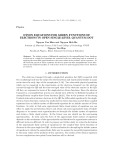
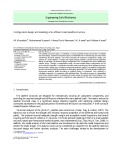
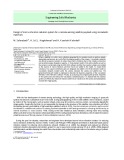
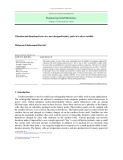
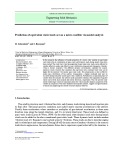



![Bài giảng Nhập môn Kỹ thuật điện [chuẩn nhất]](https://cdn.tailieu.vn/images/document/thumbnail/2025/20251208/nguyendoangiabao365@gmail.com/135x160/60591765176011.jpg)











![Bài giảng Cảm biến và ứng dụng: Chương 1 - Các khái niệm và đặc trưng cơ bản [Chuẩn SEO]](https://cdn.tailieu.vn/images/document/thumbnail/2025/20251204/kimphuong1001/135x160/51101764832169.jpg)


